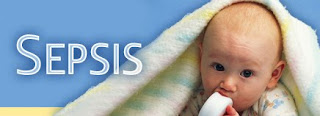Neonatal sepsis is a major health problem globally. Neonatal sepsis is a blood infection that occurs in an infant younger than 90 days old. Early-onset sepsis is seen in the first week of life. Late-onset sepsis occurs between days 8 and 89. Of newborns with early-onset sepsis, 85% present within 24 hours, 5% present at 24-48 hours, and a smaller percentage present within 48-72 hours. Onset is most rapid in premature neonates.
The baby gets the infection from the mother before or during delivery. The microorganisms most commonly associated with early-onset infection include the following :
- Group B Streptococcus (GBS)
- Escherichia coli
- Coagulase-negative Staphylococcus
- Haemophilus influenzae
- Listeria monocytogenes
- Body temperature changes
- Breathing problems
- Diarrhea
- Low blood sugar
- Reduced movements
- Reduced sucking
- Seizures
- Slow heart rate
- Swollen belly area
- Vomiting
- Yellow skin and whites of the eyes (jaundice)
Pathophysiology of Neonatal Sepsis
Neonates are particularly vulnerable to infection as a result of lower non-specific immunity (inflammation) and specific (humoral), such as low phagocytosis, chemotaxis response delay, minimal or absence of immunoglobulin A and immunoglobulin M (IgA and IgM), and low levels of complement.
Sepsis in the neonatal period can be obtained before birth through the placenta from the maternal blood stream or during labor for ingestion or aspiration of infected amniotic fluid.
Sepsis early (less than 3 days) obtained in the perinatal period, infection can occur from direct contact with the organism from the gastrointestinal or genitourinary tract maternal. The most frequent infecting organism is group B streptococcus (GBS) and Escherichia coli, which is present in the vagina. GBS emerged as a highly virulent microorganisms in the neonate, with a high mortality rate (50%) in infants exposed to Haemophilus influenzae and Staphylococcus negative coagulation are also often seen in early-onset sepsis in infants with very low birth weight.
Advanced Sepsis (1 to 3 weeks after birth) primarily nosocomial, and organisms that attack is usually staphylococci, Klebsiella, enterococcus and pseudomonas. Coagulation negative staphylococci, commonly found as the cause of septicemia in infants of low birth weight and very low birth weight. Bacterial invasion can occur through such Gated umbilical stump, skin, mucous membranes of eyes, nose, pharynx, and ear, and internal systems such as the respiratory system, nervous, urinary, and gastrointestinal.
Postnatal infection, derived from cross-contamination with other babies, personnel, or objects in the environment. Bacteria commonly found in water sources, a humidifier, sink pipes, suction machines, most equipment respiration, and arterial and venous catheters inserted used for infusion, blood sampling, monitoring of vital signs. (Donna L. Wong, 2009).
The process begins with the invasion of the pathophysiology of bacterial sepsis and systemic contamination.
The release of endotoxin by bacteria cause changes in the function of the myocardium, changes in uptake and utilization of oxygen inhibition of mitochondrial function, and progressive metabolic chaos. In sepsis sudden and severe, complemen cascade caused much death and damage cells. The result is a decrease in tissue perfusion, metabolic acidosis, and shock, disseminated intravascular coagulation resulting (DIC) and death. (Bobak, 2004).
Patients with immune disorders have an increased risk for serious nosocomial sepsis. Cardiopulmonary manifestations of gram-negative sepsis can be replicated by injection of endotoxin or Tumor Necrosis Factor (TNF). Barriers to employment TNF by anti-TNF monoclonal antibody greatly weakens manifestation of septic shock. When the bacterial cell wall components are released in the bloodstream, cytokine-activated, and can further lead to more physiological mess. Either alone or in combination, bacterial products and pro-inflammatory cytokines trigger a physiological response to stop the invaders (invader) microbes. TNF and other inflammatory mediators increase vascular permeability and vascular tone imbalance, and the imbalance between perfusion and increased metabolic needs of the network.
Shock is defined as a systolic pressure below the 5th percentile for age or defined with cold extremities. Capillary refilling the late (more than 2 seconds) is seen as a reliable indicator of a decrease in peripheral perfusion. Peripheral vascular pressure in septic shock (heat) but be very up on a further shock (cold). In septic shock tissue oxygen consumption exceeds oxygen supply. This imbalance is caused by peripheral vasodilatation in the beginning, during further vasoconstriction, myocardial depression, hypotension, ventilator insufficiency, anemia. (Nelson, 1999).
Septicaemia shows the emergence of a systemic infection of the blood caused by the rapid multiplication of microorganisms or toxic substances, which can cause huge psychological change. These substances can be pathogenic bacteria, fungi, viruses, and rickets. The most common cause of septicemia is a gram-negative organisms. If the protection of the body is not effective in controlling the invasion of microorganisms, septic shock may occur, which is characterized by hemodynamic changes, imbalance of cellular functions, and multiple system failures. (Marilynn E. Doenges, 1999).

Thanks man really nice site and some great articles I saw your website and it is very interesting, keep it up! excellent stuff. I cannot get enough!
ReplyDeletesymptoms and diagnosis of heart attack
Whenever I read Your Post Allways got Something New
ReplyDeleteBaby Care Equipments